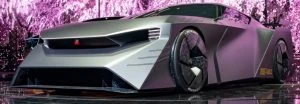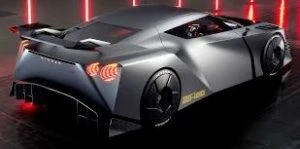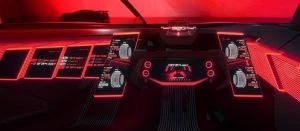Makes and Models
Hilux Baby Ute a Champ

I think plenty of people would love to get their mitts on Toyota’s cute baby Hilux. Due to the Champ’s very no frills disposition, the cost of buying a new Toyota Champ Hilux would only be around $20k if you could buy one here in Australia. However, we’ll have to wait and see if the new Hilux Champ actually makes it down under.
Toyota have launched the new Hilux Champ in Thailand, and it was a vehicle that featured, for the first time, at the recent Japan Mobility Show. At this show, it was displayed in numerous configurations to show just how versatile the little Champ can be, and so it was demonstrated as an off-road vehicle, a coffee van, and even as an ambulance.
The Champ workhorse has plenty of variety in the way it can be built up, so, for example, there are long wheel-base (3085 mm) and short wheel-base (2750 mm) variants with two different cargo trays offered. There are numerous holes for bolting down whatever you like to the cargo tray, so you could easily use this as a camper, a stock carrier for the farm, or even as a coffee van. The Champ’s payload for the cargo deck is around the 1-tonne mark.
You can also opt for any of three engines to power the little Champ. Five-speed manual and six-speed automatic gearboxes are available to link with your specific engine of choice. A rather nice 2.4-litre turbo diesel is good for 110 kW of power and 400 Nm of torque. This would be an economical engine with loads of grunt for performing any demanding tasks with relative ease. A 2.0-litre petrol has 102 kW and 183 Nm of torque, while a bigger 2.7-litre petrol produces 122 kW and 245 Nm of torque.
Luxury isn’t the Champ’s forte, so even electric windows are found only on the higher-spec models (not that this is a bad thing – I kind of miss having roll-down windows that work when the key’s out sometimes). The seats are upholstered in black vinyl, and there are a few safety features like seat belts, a strong structure, and two airbags. There is no infotainment system on-board when sold new; however it does come with two speakers, for which you can access, probably via the driver’s instrument panel.
The new Toyota Hilux Champ takes me back to the solid and reliable little 2WD Hilux and Nissan Navara utes of the eighties and early nineties. These were no frills workhorses, but they were very dependable and robust work companions. And yes, I wouldn’t mind having one.
Hydrogen-Fuelled Hiace Van Tested for Light Commercial Duties

Fancy a new van for the business? Like, I mean a really cool new van that runs on hydrogen… Well, this fancy might just be getting fulfilled a little sooner thanks to some Australian business owners who have been given a Toyota Hiace with a hydrogen-powered internal combustion engine (ICE). Yes, that’s right – hydrogen ICE – like the old school ICEs but with new technology that can allow for the cleaner burning hydrogen fuel to be burned as a much cleaner option.
Toyota’s Hydrogen Hiace Van has been undergoing testing by local businesses to see how the hydrogen ICE performs and fulfils its role for powering the Toyota Hiace van while it carries out its daily duties in the real world. If the testing goes well, showing that Toyota’s new Hydrogen ICE is a goodie, then the legendary car manufacturer will set about putting these sorts of vehicles into production.
Let’s start with what’s under the bonnet?
Toyota has designed and built the van’s hydrogen ICE, which is based on the V6 turbo-petrol ICE used in the Land Cruiser 300 model series. The LX600’s 10-speed automatic transmission has been retained in the test van, but it runs with rear-wheel-drive rather than the Land Cruiser’s all-wheel drive system. In petrol form, the V6 is able to pump out 305 kW of power and 650 Nm of torque. In hydrogen form, with the relatively minor changes, the motor puts out a decent 120 kW and 354 Nm. Toyota engineers deliberately matched the 120-kW output found in the standard Hiace 2.8-litre turbodiesel that is currently for sale. The diesel unit provides 66 Nm more torque; however, the new hydrogen ICE prototype’s output and torque sounds pretty decent for a Hiace van, which will be used primarily in business logistics and, obviously, as a trade van, which is classed in the light commercial segment.
The hydrogen fuel is stored under the van’s floor in three tanks, which is good for a range of up to 200 km. What about the emissions from the exhaust? Tailpipe emissions amount to a little bit of nitrogen oxide, and that’s it.
So why hydrogen instead of an EV Hiace?
There is the lack of emissions, but also the fact that a hydrogen Hiace van can theoretically be put into production quickly without any major changes to Toyota’s supply chain, which make the hydrogen alternative desirable from a cost and logistical point of view.

There is also the fact that Toyota gurus, and other tests, have shown that electric vehicles lose a significant amount of range when they are fully loaded up, working hard, or used for towing. Add in the fact that the van shape isn’t the most aerodynamic outline on the market, then we can see why an EV van starts to look a bit sketchy in the real world. Hydrogen, as a fuel, is far more suited for a van that will work hard with heavy loads on board, run against headwinds, or be used for towing. With hydrogen, the driving range is not as significantly impacted as what it is in an EV alternative, so the panic of running out of battery range in between jobs won’t be a concerning issue for your typical tradie – or the person waiting for the plumber to turn up to fix the loo.
Toyota is likely to bring out an Electric Hiace anyway, but they would also like to be able to provide a hydrogen Hiace in the future as well; obviously not straight away, but for when the infrastructure for hydrogen refuelling does become a reality.
On all accounts, it seems that it the prototype Toyota Hiace Hydrogen Van is capable of doing its job well, and really could be all ready for action at the drop of a hat or once the hydrogen infrastructure arrives.
The Nissan Hyper Force Concept Car

There would be little debate over whether a Nissan GT-R is a legendary supercar or not. It has been one of the most exciting cars of the last two to three decades, having even set a record on the Nürburgring racetrack of 7:08.68 min in 2013, which was achieved by the Nissan GT-R NISMO.
Recently, the Nissan Hyper Force concept car stunned the crowds at a car show in Japan. Could this concept potentially be the next new Nissan GT-R supercar?
The Nissan Hyper Force is an all-electric beast with a seriously brazen design suggesting time warp speeds! In the car’s layout is an application of some clever revolutionary solid-state batteries that enable the supercar’s output to power up to 985 kW. That’s almost 600 kW more than the current GT-R! It’s also good to see that solid-state batteries are starting to break out of the laboratory and into actual vehicles, as they have better safety performance. However, these solid-state batteries are inside something that’s got that little hit of adrenaline. This electric vehicle is electrifying.
With this level of output, the Nissan Hyper Force Concept car is carefully aerodynamically designed to ensure the air is pushed over the car to force it down on the road. In order to achieve the required levels of downforce, there are active winglets up the front end of the car to help channel air over the car, as well as a massive air scoop in the lower bumper, and an array of active fins for air manipulation. If you look at the back of the vehicle, the telltale twin LED taillight clusters are very typical of the Nissan Skyline GT-R. The massive wheel arches on the AWD machine look really spectacular, hiding what must be some serious rubber tyre profiles. If I were making a Batman movie, I’d cast this vehicle as the latest iteration of the Batmobile.

The doors open upwards and forwards in a gullwing-like action. Once the doors are opened, the onlookers are presented with a stunningly wild interior, featuring Lamborghini-crazy styling that is incredibly futuristic, offering sizzling red LED lighting vibes for high-speed driving modes. Gentler GT modes light up the interior in a blue colour. There are plenty of information displays and stylish graphics, as you’d expect. The interior styling continues the edgy, angular diagonal lines of the exterior, giving a Batmobile vibe. And did I see harness style seatbelts in there?

The Nissan Hyper Force concept was at the Japanese car show to inspire people, and to give them a taste of what a new roadgoing Nissan supercar (potentially GT-R) of the future might look like. This is seriously cool! Here’s hoping that we’ll see some of the ideas trickling down. I particularly like the idea of the ambient lighting changing with the driving style, so I hope that we see that one in upcoming Nissan models. I’d also like to see the harness-style seatbelts making their way into regular cars, though they’d take a bit of getting used to, especially for a women (but they could easily be an improvement over the three-pointers we’re used to).
Find out more and have a drool in the official promo video from Nissan:
The Fastest Wedge Of Orange In The Galaxy: The Bond Bug

It’s groovy. It’s bright orange. It’s a small car that aimed to capture the younger section of the automotive market that came out during a fuel crisis. It’s the Bond Bug. What’s more, it’s decidedly weird.
The Bond Bug isn’t like any other car found on the roads, and I very much doubt if you’ll see one on the roads of Australia, as only a few thousand were produced during its production run, which lasted from 1970 to 1974 (yes, this car is older than I am). Although the engine is fairly standard – a nice little 700 cc water-cooled inline four engine – it’s the styling that really turned heads and is still turning them. It wasn’t just the fact that the car had three wheels (which one motoring enthusiast described was either one wheel too many or one wheel too few). It also had a futuristic wedge shaped shape with a very space-age lift-up hood as well as two doors and pop-up lights. You could call it a two-door hatchfront instead of a hatchback. It seated two people on its black seats (bright orange and black – you could hardly get something more seventies than that!). It did have a boot that was able to get a small amount of luggage, such as a guitar, but that was about it. The bodywork was made from fibreglass, meaning that the vehicle was light, allowing for better fuel economy (but probably not safety!).
The looks were the brainchild of Tom Karen, a designer for the Ogle company who, among other things, designed the Raleigh Chopper bicycle, a very cool-looking bike that I vaguely remember the cool kids having when I was at primary school (if they didn’t have BMX bikes, that is). The Raleigh Chopper made a brief comeback this year, possibly to commemorate the death of Tom Karen in January 2023.
The Bond Bug was produced by Reliant. Reliant also produced another three-wheeled car, namely the Robin, which is best known as the three-wheeled car that shows up in the Mr Bean skits as the adversary of Mr Bean’s trusty little Mini. This (meaning the Robin, not the Mini) was also designed by Tom Karen.
In terms of performance, the Bond Bug wasn’t quite a supercar, shall we say? The 700ES variant boasted 23 kW of power when the curve peaked at 5000 rpm, and had 52 Nm of torque at the same number of revs. If you think that it could barely overtake a fairly speedy snail or a leisurely cyclist, the Bond Bug was capable of a top speed of 121 km/h and did the 0–100 km/h sprint (?) in 19.7 seconds. Needless to say, it had a rear wheel drive. The handling also left something to be desired.
If you think that the Bond Bug looks like something out of a sci-fi movie, you are absolutely right. In fact, Tom Karen worked with none other than George Lucas and used the chassis from a Bond Bug to create the Landspeeder that Luke Skywalker drives in the early scenes of Star Wars Episode IV: A New Hope (the anti-grav effect is done with mirrors).